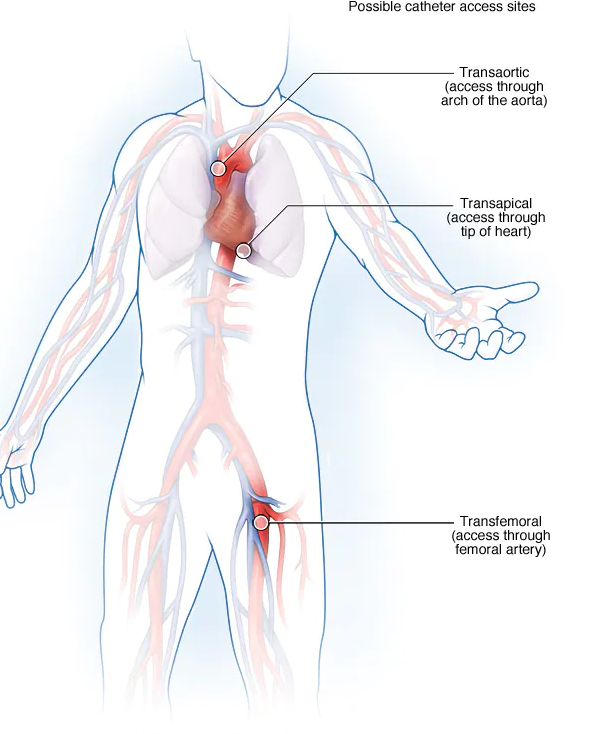Surgeries
Home / Surgeries / Transcatheter aortic valve replacement (TAVR)

Transcatheter aortic valve replacement (TAVR) is a minimally invasive heart procedure to replace a thickened aortic valve that can’t fully open (aortic valve stenosis). The aortic valve is located between the left lower heart chamber (left ventricle) and the body’s main artery (aorta). If the valve doesn’t open correctly, blood flow from the heart to the body is reduced.
TAVR can help restore blood flow and reduce the signs and symptoms of aortic valve stenosis — such as chest pain, shortness of breath, fainting and fatigue.
TAVR may be an option for people who are at risk of complications from surgical aortic valve replacement (open-heart surgery). The decision to treat aortic stenosis with TAVR is made after a discussion with a team of heart and heart surgery specialists, who work together to determine the best treatment option for you.
Transcatheter aortic valve replacement may also be called transcatheter aortic valve implantation (TAVI).
TAVR may be an option for people who are at risk of complications from surgical aortic valve replacement (open-heart surgery). The decision to treat aortic stenosis with TAVR is made after a discussion with a team of heart and heart surgery specialists, who work together to determine the best treatment option for you.
Transcatheter aortic valve replacement may also be called transcatheter aortic valve implantation (TAVI).
Why it's done
Transcatheter aortic valve replacement (TAVR) is a treatment for aortic valve stenosis. Aortic valve stenosis — or aortic stenosis — occurs when the heart’s aortic valve thickens and becomes stiff (calcifies). As a result, the valve can’t fully open and blood flow to the body is reduced.
TAVR is an alternative to open-heart aortic valve replacement surgery. People who have TAVR often have a shorter hospital stay than those who have surgical aortic valve replacement.
TAVR is an alternative to open-heart aortic valve replacement surgery. People who have TAVR often have a shorter hospital stay than those who have surgical aortic valve replacement.


Transcatheter aortic valve replacement (TAVR) involves replacing a damaged aortic valve with one made from cow or pig heart tissue (biological tissue valve). Sometimes, the biological tissue valve is placed into an existing biological tissue valve that is no longer working.
Unlike surgical aortic valve replacement, which requires a long incision down the chest (open-heart surgery), TAVR is done using smaller incisions and a thin, flexible tube (catheter) to reach the heart.
To perform TAVR, a doctor inserts a catheter into a blood vessel, usually in the groin or chest area, and guides it into the heart. Moving X-ray images or echocardiogram pictures help the doctor place the catheter into the correct position.
A replacement valve made of cow or pig tissue is passed through the hollow catheter and placed in the area of the aortic valve. A balloon on the catheter tip inflates to press the new valve into place. Some valves expand without the use of a balloon.
The doctor removes the catheter once the new valve is securely in place. During the TAVR procedure, the treatment team will carefully monitor your vital signs, including
Unlike surgical aortic valve replacement, which requires a long incision down the chest (open-heart surgery), TAVR is done using smaller incisions and a thin, flexible tube (catheter) to reach the heart.
To perform TAVR, a doctor inserts a catheter into a blood vessel, usually in the groin or chest area, and guides it into the heart. Moving X-ray images or echocardiogram pictures help the doctor place the catheter into the correct position.
A replacement valve made of cow or pig tissue is passed through the hollow catheter and placed in the area of the aortic valve. A balloon on the catheter tip inflates to press the new valve into place. Some valves expand without the use of a balloon.
The doctor removes the catheter once the new valve is securely in place. During the TAVR procedure, the treatment team will carefully monitor your vital signs, including